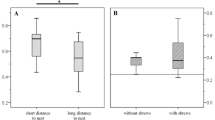Summary
Mallard ducks fed a diet containing 3 ppm DDE (equal to about 0.6 ppm in a natural succulent diet) laid eggs that contained an average of 5.8 ppm DDE; ducklings that hatched from these eggs differed from controls in behavioral tests designed to measure responses to a maternal call and to a frightening stimulus. In response to the maternal call, ducklings from parents fed DDE were hyper-responsive; compared to controls, a greater percentage approached the call and a greater percentage of those that approached remained near the call for the remainder of the test. In a test of avoidance behavior, ducklings whose parents were fed DDE traveled shorter distances from the frightening stimulus than did controls.
Similar content being viewed by others
References
BLUS, L. J., A. A. BELISLE, and R. M. PROUTY. Pestic. Monit. J.7, 181 (1974).
HAEGELE, M. A. and R. H. HUDSON. Environ. Pollut.4, 53 (1973).
HEINZ, G. Bull. Environ. Contain. Toxicol.13, 554 (1975).
JAMES, D. and K. B. DAVIS, Jr. Amer. Zool.5, 229 (1965).
JEFFERIES, D. J. Ibis109. 266 (1967).
JEFFERIES, D. J. Mededel. Fakulteit Landbouwwetenschap. Gent.36, 34 (1971).
KARLSSON, B., B. PERSSON, A. SÖDERGREN, and S. ULFSTRAND. Environ. Pollut.7, 53 (1974).
KEITH, J. A. and I. M. GRUCHY. Proc. 15th Int. Ornithol. Cong., The Hague, 437 (1972).
KREITZER, J. F. and G. H. HEINZ. Environ. Pollut.6, 21 (1974).
LONGCORE, J. R. and B. M. MULHERN. Pestic. Monit. J.7, 62 (1973).
PEAKALL, D. B. Science168, 592 (1970).
WIEMEYER, S. N., B. M. MULHERN, F. J. LIGAS, R. J. HENSEL, J. E. MATHISEN, F. C. ROBARDS, and S. POSTUPALSKY. Pestic. Monit. J.6, 50 (1972).
ZITKO, V. and P. M. K. CHOI. Bull. Environ. Contam. Toxicol.7, 63 (1972).
Author information
Authors and Affiliations
Rights and permissions
About this article
Cite this article
Heinz, G.H. Behavior of mallard ducklings from parents fed 3 ppm DDE. Bull. Environ. Contam. Toxicol. 16, 640–645 (1976). https://doi.org/10.1007/BF01685567
Published:
Issue Date:
DOI: https://doi.org/10.1007/BF01685567




